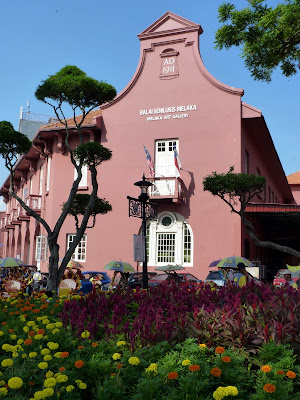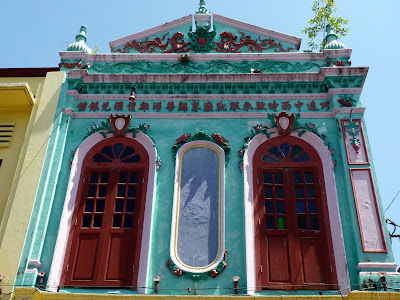As a follow-up to our last post on the colonial city of George Town on the island of Penang, here are some pictures from George Town's colonial cousin, Melaka. Melaka is fascinating because of the different layers of its long colonial history: The Portuguese left their mark in the 16th century, then the Dutch in 17th and 18th centuries, and then the British in the 19th and 20th. Even Jeremy, who couldn't wait to escape the heat and humidity of Malaysia, had high praise for Melaka, saying: "Yeah, it is really pretty."
One of the city's distinctive features is the many colorful rickshaws, festooned with artificial flowers and fanciful decorations, sparkling with strings of twinkling lights, and booming with pop music favorites. Another is the rust-red colonial buildings on Melaka's main square, which sits on a picturesque little river across from the city's colorful Chinatown neighborhood. Not far from the square are the roofless remains of St. Paul's, an old stone church on a hill overlooking what's left of the Portuguese fort.
Melaka a great place to wander aimlessly, except in the searing heat of the middle of the day - which is a good time to escape into one of the city's many dining establishments for a tasty local specialty, like sweet little pineapple tarts or chicken with rice balls, a unique Malaysian translation of a Chinese dish from Hainan province. Enjoy the pictures, and see you in Paris!
 |
| Remains of Portuguese fort |
 |
| Remains of St. Paul's, a church built by the Portuguese, then reconsecrated by the Dutch |
 |
| Dutch tombstone at St. Paul's |
 |
| Sultan's Palace |
 |
| Our favorite chicken and rice ball restaurant |
 |
| Melaka at night |
 |
| It's not dark yet, but it is happy hour |
 |
| Dutch cemetery near our hotel |



























































